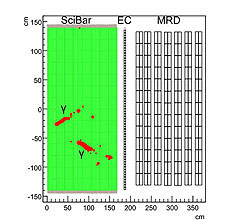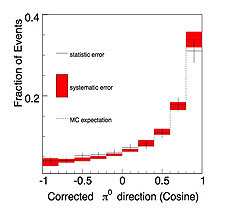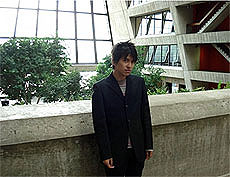SciBooNE searches for neutral pions

Figure 1. An event display showing a typical π0 interaction in the SciBooNE detector. Each red dot represents energy deposited in one detector channel. The SciBooNE analyzers use the positions and sizes of the energy deposits to reconstruct the directions and total energies of the particles whose passage caused the tracks to develop. In a typical π0 event, the pions decay to two photons. Those photons subsequently convert to electron-positron pairs that leave tracks, as shown in this display. The tracks point back to the position of the π0 decay.
Detecting the ghostly neutrino is never an easy task, especially if its interaction produces another neutral particle, the neutral pion, or π0. But detecting the neutral pion produced by neutrinos is just what the SciBooNE collaboration has achieved.
The trick is knowing what the neutral particles are going to do once they appear in the detector. Neutral pions decay very quickly into two photons, which can be detected, as shown in Figure 1. By finding the tracks left by the photons and checking if they can be reconstructed into a particle with the mass of a pion, SciBooNE analyzers, led by Yoshinori Kurimoto of Kyoto University, identified hundreds of these elusive events.
Once they found the events, the analyzers calculated the probability for neutrinos to interact in this way. They then further refined the data and carefully studied the properties of the pions created by the neutrino interactions, such as the directions in which the pions traveled through the detector, as shown in Figure 2.
Apart from the intrinsic interest of understanding the behavior of nature's quirkiest particle, these measurements provide important input for the T2K experiment in Japan. T2K is searching for muon neutrinos that morph into electron neutrinos, νe. This phenomenon, called neutrino oscillation, is the first observation not allowed by the Standard Model of particle physics. T2K and Fermilab's NOvA experiment will use accelerator neutrino beams to search directly for νe appearance. If they find it, νe appearance could be the first step in understanding why we live in a matter, not antimatter, universe. But in order to find νe appearance, the T2K and NOvA scientists will need to understand all the processes that could mimic the particle. The number one culprit is π0 production.
The SciBooNE measurements of π0 production, combined with MiniBooNE's recent results on the same topic, finally bring this pesky background process under control. More details on the analysis can be found in SciBooNE's recent publication.
-- Morgan Wascko

Figure 2. Distribution showing the angles (with respect to the neutrino beam direction) of emitted pions. The data are shown by the black crosses, with the statistical uncertainty indicated by the black error bar. The prediction is shown by the blue dashed line, with the systematic uncertainties indicated by the red bands.

Yoshinori Kurimoto of Kyoto University performed the data analysis.
|